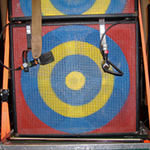Maria Walker
Four Rooms
John Davis Gallery
362½ Warren Street, Hudson, NY
August 16–September 9, 2012
The rugged, ragged work of the Brooklyn-based artist Maria Walker—painted wooden-slat constructions, acrylic-soaked canvases straining over irregularly shaped stretchers, and postcard-size frescos fused onto burlap and mounted on square panels—is well suited for the raw concrete rooms of John Davis Gallery’s gutted carriage house. With their tough, unfinished beauty, the fourteen pieces shown here evoke a romantic preoccupation with the passing of time yet are never overly sentimental. Walker’s work also feels nostalgic in light of recent art history, recalling in particular the elegant experimental approaches to painting from the 1970s (Elizabeth Murray, Ron Gorchov) and the manneristically mutilated work by Steven Parrino from the past three decades—but with much less angst.
Her process is key to her work: The largest painting, Summer—Summer Solstice (2011–12), involved a patient system of staining an unprimed canvas over the course of a year, pouring rich, diverse hues of paint inward from the stretcher bars’ bulky and mountain perimeter, with its dozen protrusions underneath the cotton. She produced the smaller, equally multicolored Calendar 1–65 (Skowhegan, ME) (2011) over two months, and the monochromatic baby-blue Birthday 32 (2012) even quicker, in a day, with a circle of twelve jagged blocks underneath the saturated fabric liner symbolizing a clock’s hours.
Walker acknowledges the source of her support materials by adding a figurative element—the tree—into many of her works, especially her three-dimensional structures. A painting of a barren grayish-brown trunk and branches, March Tree (2011–12), is wrapped around a skewed stretcher that stands upright. The object casts a long winter shadow, composed of wooden slats arranged on the floor behind it, which are messily painted sky blue and leaf green. Another work, Return (2011–12), abandons painting entirely: The artist removed an unsatisfactory canvas from its supporting brace, leaving behind a rough but elegant sunburst pattern to hang on the wall.
Originally published at Artforum.com on September 4, 2012.
